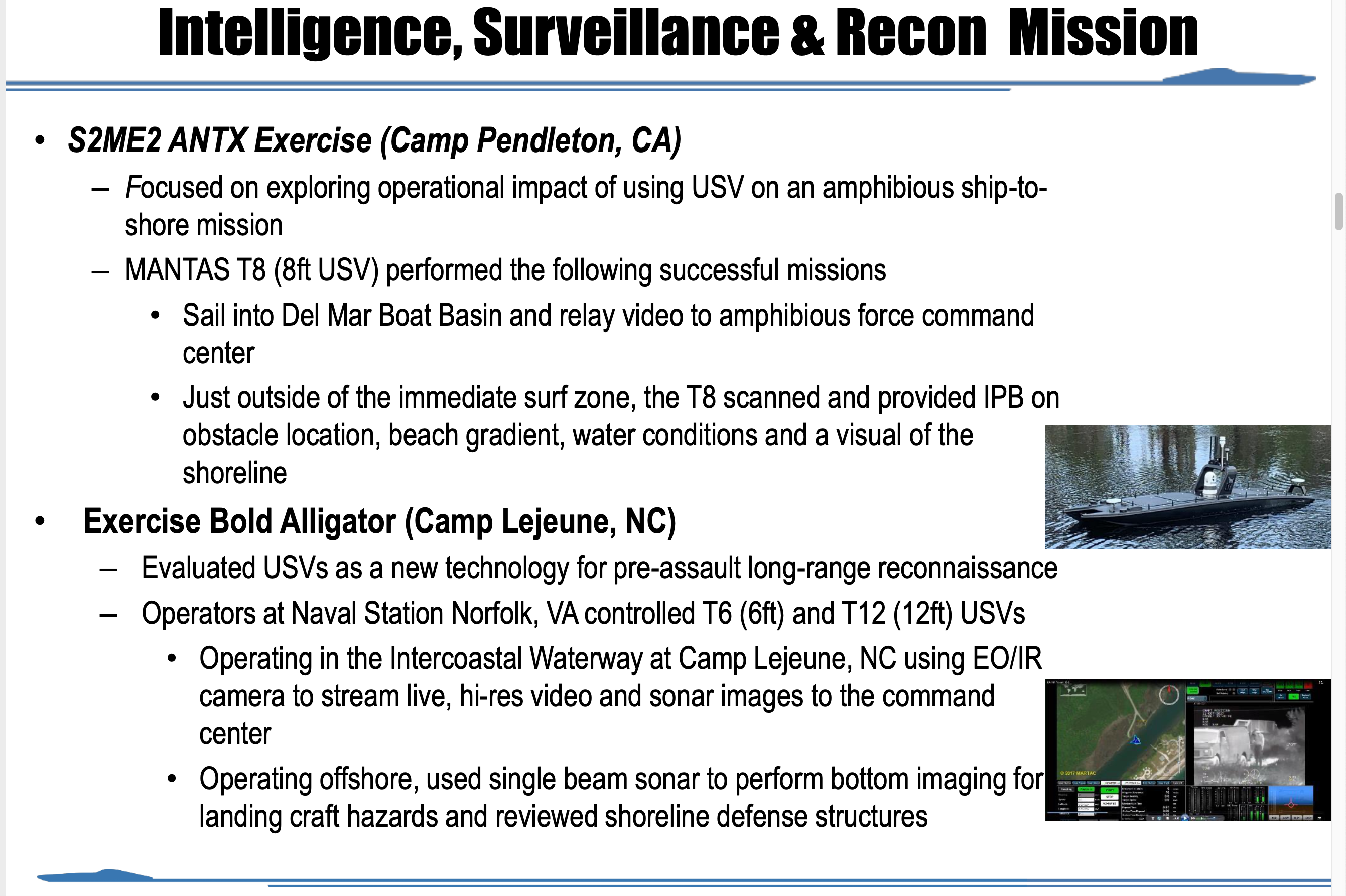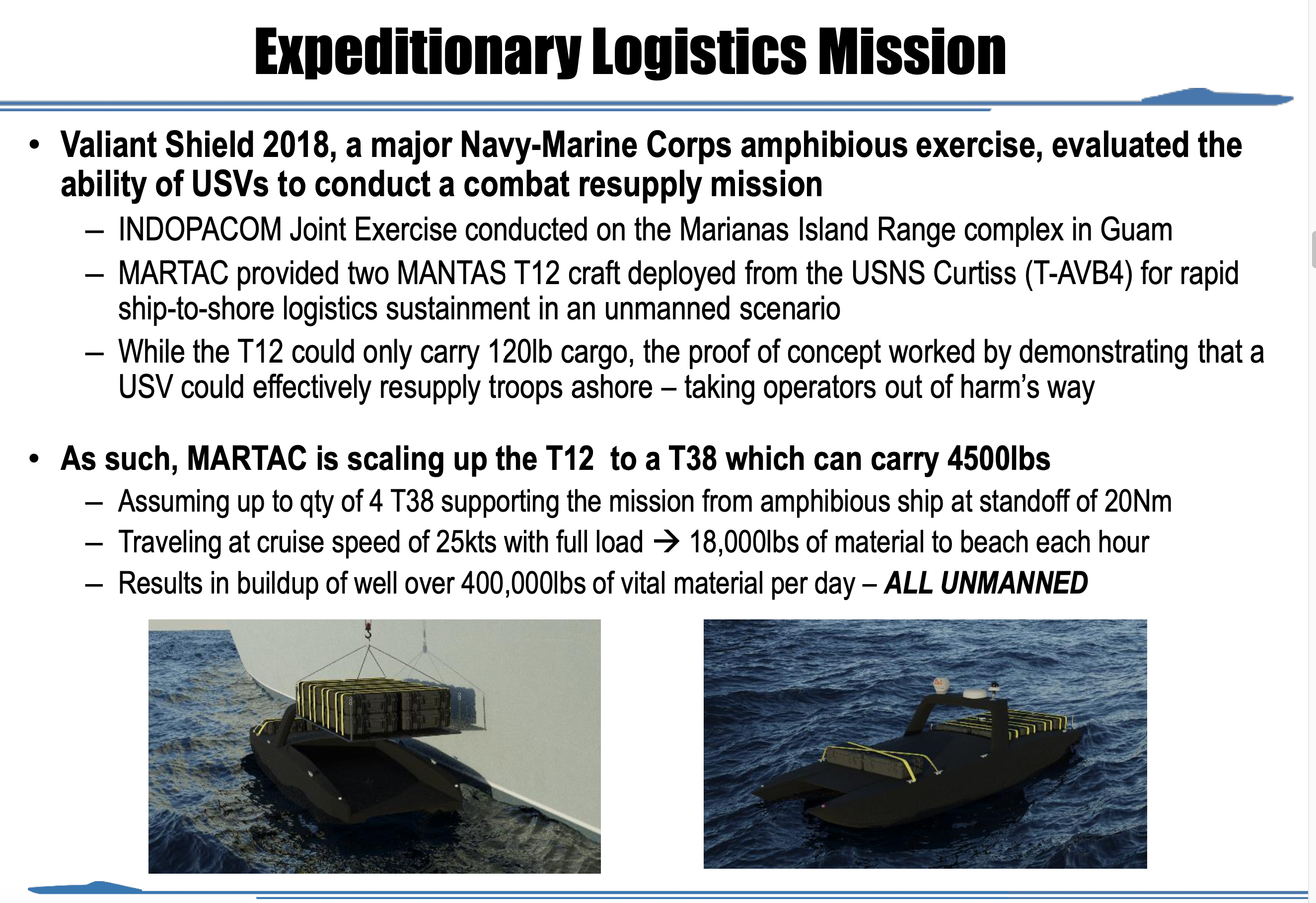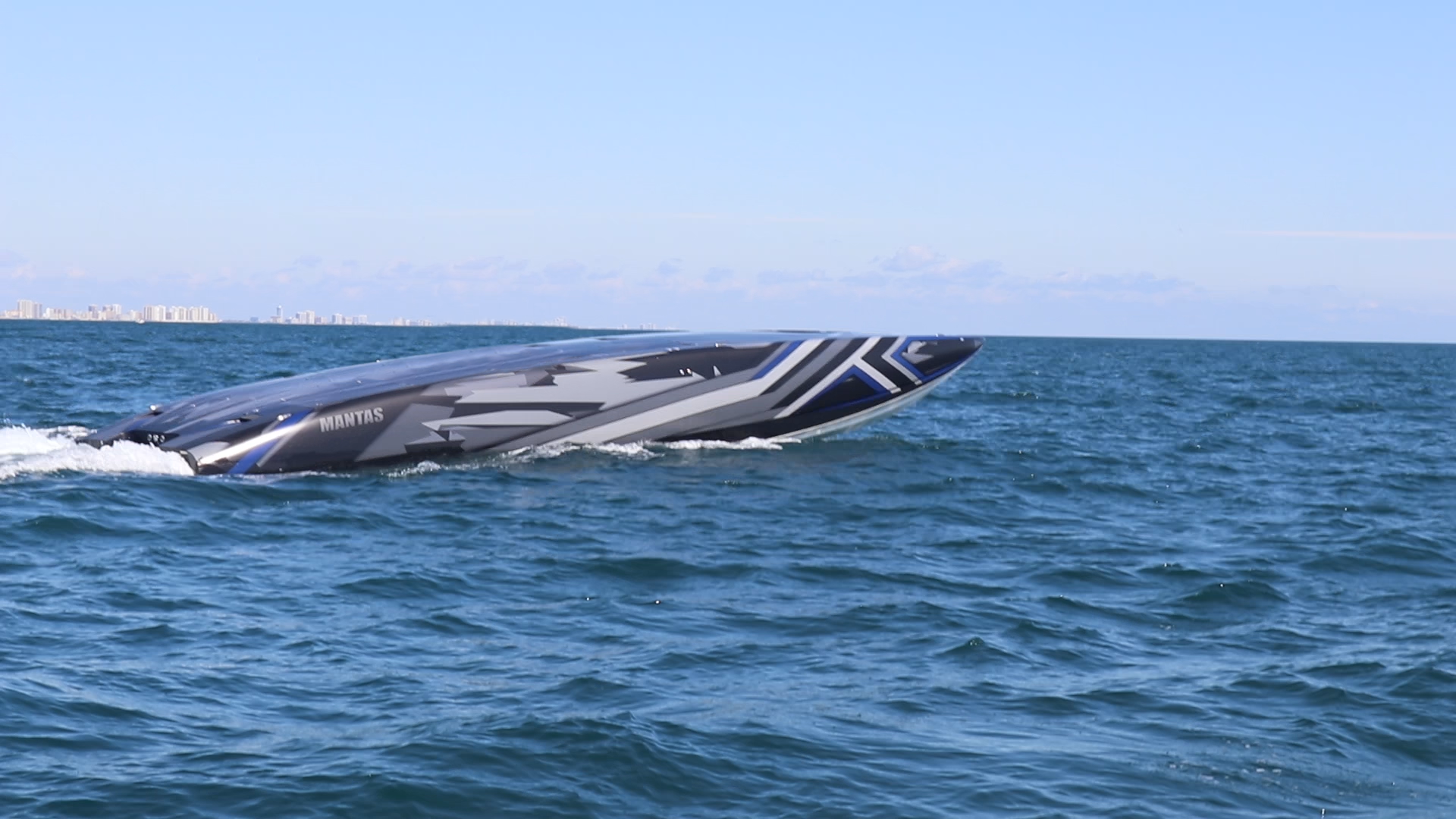The U.S. Navy and USMC Work a Way Ahead with Unmanned Surface Vessels: A Case Study of the MANTAS and DEVIL RAY USV
Years ago, I was the lead Naval Architect/Naval Engineer on the design team for an unmanned surface vehicle that ultimately evolved into the Sea Hunter craft currently being evaluated by the Navy’s Surface Development Squadron.
Currently, I serve as the Chief Technology Officer (CTO) for Maritime Tactical Systems Inc. (MARTAC) which manufactures a family of catamaran-hull “MANTAS” (8-12ft) and the larger “DEVIL RAY” (24-50ft) unmanned surface vehicles (USV).
I have stewardship in placing these craft into exercises and have already seen them perform a number of different missions.
While I am a fan of the MANTAS and DEVIL RAY USV, this is not an industry pitch advocating one platform as the only solution to the Navy’s unmanned surface vehicle needs.
Rather, as the Navy weighs the long lead times involved in designing USVs from the keel up, we advocate a parallel path solution using commercial off the shelf components like MANTAS or DEVIL RAYs to deliver a near-term solution to meet urgent Fleet needs.
What follows is how the Navy and Marine Corps have previously used the MANTAS USVs to perform the intelligence surveillance and reconnaissance, expeditionary logistics, and mine countermeasures missions.
Doing these missions, underscored the need to design and build the larger, upscaled, Expeditionary Class DEVIL RAY USV.
Intelligence Surveillance and Reconnaissance Missions
For centuries, commanders have struggled to collect enough information to give them the edge in combat.
As the Duke of Wellington famously said, “All the business of war is to endeavor to find out what you don’t know by what you do; that’s what I call guessing what’s on the other side of the hill.”1
From Salamis, to Lepanto, to Trafalgar, to Jutland to other naval battles, commanders have attempted to lift the “fog of war” by determining where the enemy was sailing.
In a naval engagement that marked the turning point of World War II, the Battle of Midway turned on one commander locating his adversary first. U.S. Navy PBY scout planes located the Japanese carriers first, while the Japanese Imperial Navy found the U.S. Navy carriers too late to launch an effective attack. Had Admiral Yamamoto learned the location of his adversary’s carriers just a bit sooner, he might well have been victorious.2
The need to know “what’s on the other side of the hill,” is especially acute for the Navy and Marine Corps in the area of amphibious assault.
The prospect of assaulting a heavily defended beach without knowing as much as possible about adversary forces and obstacles courts disaster.
For this reason, Navy and Marine Corps officials invited MARTAC to have MANTAS as part of several exercises, experiments and demonstrations in order to evaluate its ability to support the ISR and Intelligence Preparation of the Battlefield (IPB) missions during an amphibious assault.

There are few missions more hazardous to the Navy-Marine Corps team than putting troops ashore in the face of a prepared enemy force.
For the amphibious assault mission, UAVs are useful—but are vulnerable to enemy air defenses. UUVs are useful as well, but the underwater medium makes control of these assets at distance problematic.
For these reasons, the expeditionary assault force has focused on evaluating unmanned surface vehicles to add to their “kit” to conduct critical ISR and IPB missions.
The Ship-to-Shore Maneuver Exploration and Experimentation (S2ME2) Advanced Naval Technology Exercise (ANTX) (S2ME2 ANTX) provided an opportunity to demonstrate innovative technology that could be used to address gaps in capabilities for naval expeditionary strike groups.
S2ME2 ANTX had a focus on unmanned surface systems that could provide real-time ISR and IPB of the battlespace.
During the assault phase of S2ME2 ANTX, the expeditionary commander used a USV to thwart enemy defenses.
The amphibious forces operated an eight-foot MANTAS USV which swam into the enemy harbor (the Del Mar Boat Basin on the Southern California coast), and relayed information to the amphibious force command center using its TASKER C2 system. Once this ISR mission was complete, the MANTAS USV was driven into the surf zone to provide IPB on obstacle location, beach gradient, water conditions and other information crucial to planners.
S2ME2 ANTX was a precursor to Bold Alligator, the annual U.S. Fleet Forces Command (USFFC) and U.S. Marine Corps Forces Command (MARFORCOM) expeditionary exercise.
Bold Alligator was focused on conducting amphibious operations, as well as evaluating new technologies that support the expeditionary force. The early phases of Bold Alligator were dedicated to long-range reconnaissance. Operators at the exercise command center at Naval Station Norfolk drove the six-foot and 12-foot MANTAS USVs off North and South Onslow Beaches, as well as up and into the Intracoastal Waterway.
Both MANTAS USVs streamed live, high-resolution video and sonar images to the command center. MANTAS performed well in these exercises, experiments and demonstrations and the efficacy of using unmanned surface vehicles to perform the pre-assault ISR and IPB missions.
And doing so, while keeping Sailors and Marines out of harm’s way. The reasons for the importance of being able to do so are abundantly clear as an article in Defense Daily put it:
The Chief of Naval Operations (CNO) this week said the unmanned vessels planned in the Navy’s new future fleet plan will help fill in gaps in intelligence, surveillance, reconnaissance and targeting (ISR&T) in a larger more distributed fleet. “With a more distributed force, we’re going to potentially come at the adversary across a bunch of different vectors and we’re assuming the adversary is going to continue to grow in numbers.” Gilday said the Navy will require a high degree of organic ISR. “And so it’s a gap that is going to continue to widen unless, I think, we move heavier in the direction of unmanned and rely more on unmanned for many of those functions.”3
As the Chief of Naval Operations comments make clear, intelligence, surveillance, reconnaissance (and targeting) is a critical factor in the success of all naval missions, and one that is fraught with danger when dealing with peer competitors. Using the advanced technology of unmanned platforms to perform this mission and keep operators out of harm’s way is an important capability to continue to develop and field.
Expeditionary Logistics Mission
While ISR and IPB are crucial in an amphibious assault, once the assault is underway and Marines are on the beach, a critical factor in ensuring their success is rapid resupply. Using manned naval craft to do this mission puts operators and vessels at unnecessary risk.
A major Navy-Marine Corps amphibious exercise, Valiant Shield, evaluated the ability of unmanned surface vehicles to conduct this resupply mission.
Expeditionary logistics are often an overlooked mission because is not a topic that typically evokes deep passion, but it should be. Almost four decades ago, General Robert Barrow, Commandant of the United States Marine Corps, coined a phrase that is still a staple of U.S. War College curricula: “Amateurs talk about tactics, but professionals study logistics.” More recently, at the 2019 USNI/AFCEA “West” symposium, Brigadier General Arthur Pasagian, Commander, Marine Corps Systems Command, noted, “Logistics is a key enabler for all we do.”
One doesn’t need to be a Clausewitz or Sun Tzu to understand the importance of logistics to warfare over many millennia. For the Navy-Marine Corps team, this plays out most prominently during an amphibious assault.
The INDOPACOM Joint Forces Valiant Shield exercise, overseen by Commander Marine Forces Pacific (MARFORPAC) and conducted on the Marianas Island Range Complex, experimented with using emerging technology to provide sustainment to Marines on the beachhead during this critical juncture of an amphibious assault.
Marines in the fight use enormous quantities of fuel, food, ammunition and other material as they attempt to move off the beachhead. Once the assault is underway and Marines are on the beach, sustainment is crucial in ensuring their success.
The mission will ultimately fail if the Marines are not able to have reliable and continuous sustainment.

MARFORPAC used USVs during Valiant Shield 2018 to resupply the landing force.
The exercise coordinator used a catamaran hull, 12-foot MANTAS USV to provide rapid ship-to-shore logistics sustainment (seen in the featured photo). While this small, autonomously operated, USV carried only one hundred and twenty pounds of cargo between the beach and an offshore MSC supply ship, the proof-of-concept worked and demonstrated that unmanned surface vehicles could effectively resupply troops ashore.
Using unmanned vehicles for the sustainment mission can be a game-changer for expeditionary assault forces.
Beyond taking operators out of harm’s way, using USVs in this role frees manned craft for other missions. Additionally, having a continuous, preprogrammed, logistics resupply process to perform one of the dull, dirty and dangerous functions important in an amphibious assault means that there is one less thing for the commander to have to manage during these operations.
This proof-of-concept with a 12-foot MANTAS USV achieved positive results.
That said, resupply in 120-pound increments is far less than is required to provide what is needed by the Marines on the beach. The Valiant Shield exercise provided the impetus and inspiration to continue to explore the use of USVs for amphibious force sustainment. Now, the Navy and Marine Corps are looking to “scale-up” small USVs and continue to experiment with using larger USVs to provide larger sustainment quantities.
To undertake this scaling-up effort, the maker of the MANTAS family of USVs (Maritime Tactical Systems, Inc.) was asked by the Navy and Marine Corps to develop a larger proof-of-concept unmanned surface vehicle for this logistics sustainment mission using the same catamaran hull design as the smaller vessel used in Valiant Shield.
MARTAC has moved out in this effort, and in July 2020 a 38-foot (T38) DEVIL RAY was a key platform evaluated by Navy officials during Exercise Trident Warrior in San Diego.

While the T38 may not be the ultimate size for the USV the expeditionary assault force needs as a long-term solution, it will go a long way to advancing the state of the art in unmanned semi-autonomous or autonomous logistics support.
The basic specifications of the 38-foot DEVIL RAY will provide an indication of the ability of USVs to provide a steady, continuous stream of logistics support to Marines on the beach.
The T38 can carry a payload up to 4,500 pounds. The vessel travels at cruise speed of 25-40 knots and draws just 18 inches of draft. Additionally—and importantly for an amphibious assault—the T38 has a burst speed in excess of 80 knots. Given the speed and carrying capacity of the T38-sized USV, it is readily apparent on how it can fulfill this, and other important logistics functions.
Over 2,500 years ago, Sun Tzu noted, “The line between disorder and order lies in logistics.” The Navy and Marine Corps would be well served to leverage what has already been demonstrated in exercises such as Valiant Shield and explore the advantages of using unmanned surface vehicles to rapidly, reliably and continuously resupply troops ashore.
Mine Countermeasures Mission
Mine warfare is not new. Over 150 years ago, Admiral David Farragut became famous for “damning torpedoes” (mines) at the entrance to Mobile Bay during the Civil War. The use of mines and countermeasures to mines have figured significantly in every major armed conflict and nearly every regional conflict in which the United States has been involved since the Revolutionary War.
Mine warfare is an essential warfare capability integral to the ability of naval forces to open and maintain sea lines of communication and to dominate the littoral battlespace.
In the past several decades, rogue states have indiscriminately employed sea mines.
Libya used mines to disrupt commerce in the Gulf of Suez and the Strait of Bab el Mandeb. Iran laid mines to hazard military and commercial traffic in the Arabian Gulf and Gulf of Oman. During Operation Desert Storm, the threat of mines precluded the effective use of the Navy and Marine Corps expeditionary task force off the shores of Kuwait and hazarded all U.S. and coalition forces operating in the Arabian Gulf.
Indeed, Operation Desert Storm highlighted the importance of mine warfare with the near catastrophic damage to USS Samuel B. Roberts (FFG 58), USS Princeton (CG 59) and USS Tripoli (LPH 10).

In terms of availability, variety, cost-effectiveness, ease of deployment and potential impact on naval expeditionary operations, mines are some of the most attractive weapons available to any adversary determined to prevent naval forces from achieving access to sea lines of communications or the littorals. Worldwide proliferation of mines compounds this challenge.
The number of countries with mines, mining assets, mine manufacturing capabilities, and the intention to export mines has grown dramatically over the past several decades.
While many analysts evaluate the ability of the United States to deal with peer adversaries such as China and Russia in terms of cutting-edge technologies such as hypersonic missiles, directed energy weapons, fifth- and sixth-generation fighters, artificial intelligence, machine learning and other advances, both of these nations are likely to employ mines in any conflict with the United States.
Even the threat of mines can stop any naval operation dead in its tracks. The use of sea mines adjacent to maritime choke points presents a threat that is at once ubiquitous and deadly.
This is a threat that the Surface Force must contend with, as naval expeditionary forces must pass through a number of these restricted sea areas to reach their objective area.
Over the past several years, in a series of exercises, experiments and demonstrations, the U.S. Navy has field-tested wide range of commercial-off-the-shelf unmanned technologies, many of them adaptable to the MCM mission. Viable candidates have emerged that will enable Navy ships to reach their objective area by leveraging unmanned technologies to deal with deadly sea mines.
While a complete end-to-end technical description of all the details of the solution to the MCM challenge is beyond the scope of this paper, it is important to emphasize that the components of this system-of-systems are not based on just concepts or drawings or early-stage prototypes.
Rather, every element has been in the water and tested in the operational environment.
While there are many candidate unmanned surface vessels that could serve as the platform or “truck” for a COTS MCM solution, one that has operated in exercises such at Trident Warrior 2020 is the DEVIL RAY commercial-off-the-shelf high-speed catamaran. This 38-foot USV—nicknamed the T38—is virtually identical in size to an eleven-meter RHIB carried by many naval ships. The T38 can operate in up to sea state five, has a cruise speed significantly greater than that of an eleven-meter RHIB and a range four times greater than the RHIB.
One of the most important attributes of this autonomous MCM solution building block is the fact that the production T38 will have an aft-mounted twin tow station which houses both a mine-hunting sonar system and a mine neutralization system (MNS) remotely operated vehicle (ROV). These towed subsystems will be installed on two rails aft.
The catamaran hull, designed with variable ballasting, will enable the DEVIL RAY to conduct an angled “ballast down” submergence of the stern tow station. This unique configuration results in a flooded angled well-deck that facilitates a straightforward launch, tow-operations and recovery of the towed craft.
While this is a new and unique naval architecture design for an autonomous craft this size, it is a challenge that is easily met with a catamaran-style hull.
There is an urgency to provide an innovative, unmanned MCM capability for the Navy that keeps our Sailors out of the minefield. Legacy capabilities now in use employ a 25-30-year-old fleet of Avenger class MCM vessels and equally old MH-53E Sea Dragon helicopters. Planned Littoral Combat Ship MCM mission modules have capability gaps, development delays and are leaving an unacceptably narrow margin between obsolescence of legacy capability and transition to full operational capability of these new mission modules.
In short, the MANTAS and DEVIL RAY have evolved as the various opportunities to work with the US Navy and USMC in exercises and to deliver various capabilities, ISR, logistics and counter-mission missions.
The MANTAS and DEVIL RAY are scalable craft which can accommodate a range of payloads and to do so from a similarly configured craft of various sizes. This provides an opportunity to provide for common logistical support for a USV force embedded within the wider fleet.
For a PDF version of this paper, see below:
The US Navy and USMC Work a Way Ahead with Unmanned Surface VesselsFor an e-book version of this paper, see below:
Footnotes
- Duke of Wellington, cited in Louis Jennings (ed), The Correspondence and Diaries of the Late Right Honourable John Wilson Croker, Secretary to the Admiralty from 1809 to 1830 (Albemarle Street, London: John Murray, 1885).
- Craig Symonds, The Battle of Midway (Oxford, U.K.: Oxford University Press, 2011).
- Rich Abott, “CNO: Unmanned Ships To Fill ISR Gaps,” Defense Daily, October 14, 2020.

